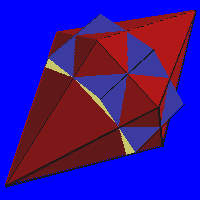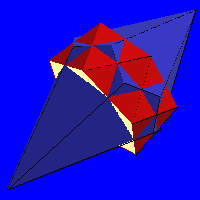Pyramids, Dipyramids, and Trapezohedra
(Incidentally, the Egyptian pyramids have square bases but the triangular side faces are not quite equilateral. They closer to half a golden rhombus. There is no reason to suppose that was intentional.)
Joining two pyramids at their bases gives the set of three dipyramids, in which all faces are equilateral triangles: the triangular dipyramid, the octahedron (square dipyramid), and the pentagonal dipyramid. These fall within the class of convex equilateral deltahedra.
 There
are two geometrically distinct classes of dipyramids which are not always
distinguished terminologically. The above could be termed equilateral
dipyramids because their faces are equilateral triangles. The other
class of dypyramids are the duals to the prisms.
These form an infinite set and are not equilateral except for the dual
to the cube, the octahedron, which falls in both classes of dipyramids.
As an example, here is the compound
of the hexagonal prism and its dual hexagonal dipyramid, clearly showing
their dual relationship and the fact that the triangles are not equilateral.
There
are two geometrically distinct classes of dipyramids which are not always
distinguished terminologically. The above could be termed equilateral
dipyramids because their faces are equilateral triangles. The other
class of dypyramids are the duals to the prisms.
These form an infinite set and are not equilateral except for the dual
to the cube, the octahedron, which falls in both classes of dipyramids.
As an example, here is the compound
of the hexagonal prism and its dual hexagonal dipyramid, clearly showing
their dual relationship and the fact that the triangles are not equilateral.
 Parallel
to the prisms and their dual dipyramids, there is an infinite series of
antiprisms and their duals, called trapezohedra.
This is a confusing nomenclature because the
faces of these polyhedra are not trapezoids in the modern sense of the
word. The faces are "kite shaped" with two sets of two equal adjacent faces.
As an example, here is the hexagonal
antiprism, the dual hexagonal
trapezohedron, and their compound.
Parallel
to the prisms and their dual dipyramids, there is an infinite series of
antiprisms and their duals, called trapezohedra.
This is a confusing nomenclature because the
faces of these polyhedra are not trapezoids in the modern sense of the
word. The faces are "kite shaped" with two sets of two equal adjacent faces.
As an example, here is the hexagonal
antiprism, the dual hexagonal
trapezohedron, and their compound.
Here is a list of pyramids, dipyramids
and trapezohedra based on triangular up to decagonal prisms and
antiprisms.